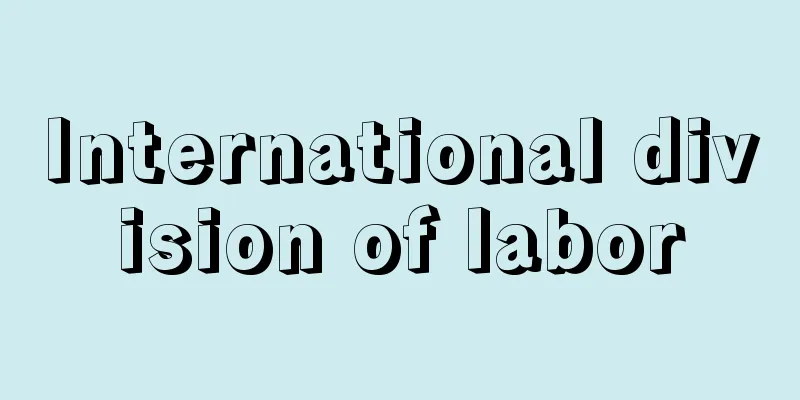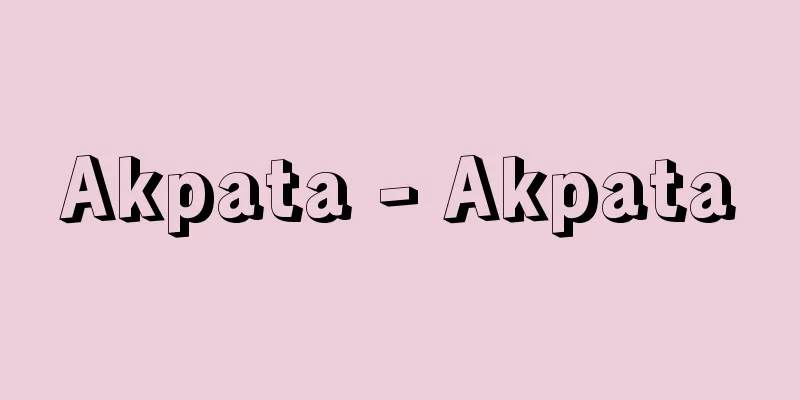International division of labor

|
Taking advantage of the production aptitudes that each country possesses, it specializes in the production of goods that are most suitable for it (called international specialization). This international division of labor results in the international exchange of goods (trade). As Adam Smith pointed out, there are divisions of labor that divide up work (technical division of labor) and those that differentiate occupations (social division of labor), and both are the greatest causes of increasing productive efficiency. International division of labor is the latter meaning of division of labor, in which each country shares production fields according to its production aptitudes. A famous theory that clarifies under what conditions the international division of labor occurs and the nature of its benefits is the theory of comparative production costs or comparative advantage proposed by Ricardo. This theory expresses the suitability of each country in terms of production costs, and states that each country should specialize in the production of goods that have relatively low production costs, i.e., a comparative advantage, and export those goods, and import goods that have relatively high production costs, i.e., a comparative disadvantage. By doing so, each country can increase its own production efficiency, which in turn brings benefits to the world as a whole (increased production volume or saving of production resources). When a country specializes in a production field in which it has a comparative advantage, there are cases where it completely stops producing goods in which it has a comparative disadvantage, and cases where production continues, albeit reduced. The former case is called complete specialization, and the latter case is called incomplete specialization. According to the theory of comparative production costs, trade occurs when there are differences in production costs between countries. In other words, differences in production costs determine the products each country exports, and exchange through trade occurs. In that sense, this theory is also called the theory of determining the international division of labor pattern. There are two ways of thinking about the determination of the international division of labor pattern, that is, why differences in production suitability, that is, differences in production costs, occur between countries. One argues that the natural and social conditions of production are different in each country, and that these differences cause differences in production costs. Natural conditions, that is, resource distribution and climate, differ from country to country. There are places where oil can be extracted and places where it cannot, and places where cotton can be cultivated and places where it cannot. There are also differences in social conditions, that is, human capabilities (dexterity of hands and scientific ability) and past legacies (factories, railways, etc.). This is the idea that differences in resource distribution and human capabilities cause differences in production costs between countries. As is well known, land, labor, and capital are called general production factors. In contrast, resource distribution and human capabilities are specific factors. Therefore, this idea is called the specific factor theory. The other idea is that differences in the amounts of general production factors, such as capital and labor, present in each country cause differences in production costs in each country, and is also known as the general factor theory. This is also called the Heckscher-Ohlin theorem (H-O theorem) after the proponent of this theory. Note that when trade between developed countries (trade of manufactured goods) rapidly increased after World War II, the technology gap theory, which focuses on technological innovation as the cause, and the R&D (research and development) factor theory can be said to be new developments of the specific factor theory. There are also two types of international division of labor: vertical and horizontal. Vertical international division of labor refers to trade between industrial products from developed countries and primary products (raw materials such as agricultural products and iron ore) from developing countries, while horizontal international division of labor refers to trade of industrial products, primarily heavy chemical products, between developed countries. After World War II, the traditional vertical international division of labor declined, while horizontal international division of labor became more popular. As a result, the proportion of trade between developed countries in world trade has been expanding. [Kisuke Tanaka] "Foreign Trade" by Kiyoshi Kojima (1981, Shunjusha) ▽ "International Economics" by R.F. Harrod, translated by Shigeru Fujii (1976, Jitsugyo no Nihonsha) ▽ "The Wealth of Nations I" by Adam Smith, supervised translation by Kazuo Okochi (1976, Chuokoron-Shinsha) [Reference] |Source: Shogakukan Encyclopedia Nipponica About Encyclopedia Nipponica Information | Legend |
|
各国が所有する生産上の適性を生かし、もっとも適合した商品の生産に専門化(国際的特化という)すること。この国際分業の結果として商品の国際的交換(貿易)が発生する。分業には、アダム・スミスが指摘したように、作業を分割するもの(技術的分業)と職業を分化するもの(社会的分業)とがあり、ともに生産能率を増進させる最大の原因となるものである。国際分業は後者の意味の分業であり、各国が生産上の適性に応じて生産分野を分担しあうことである。 国際分業はどういう条件のもとに発生するか、その利益はどういう性質のものかについて明らかにした有名な学説として、リカードが唱えた比較生産費説または比較優位説といわれる理論がある。これは、各国の適性を生産費で表現し、各国は相対的に生産費が低い、つまり比較優位をもっている商品の生産に特化(国際分業)してそれを輸出し、相対的に生産費が高い、つまり比較劣位にある商品を輸入すべきであり、そうすることによって、各国は自国の生産能率を高め、ひいては世界全体の利益(生産量の増大または生産資源の節約)をもたらす、というものである。自国が比較優位にある生産分野に特化する場合、比較劣位にある商品の生産をまったく行わなくなるケースと、生産は縮小するが継続するというケースがある。前者のケースを完全特化、後者のケースを不完全特化という。 比較生産費説によれば、各国の生産費に相違があれば貿易が行われる。すなわち、生産費の相違が各国の輸出品を決定し、貿易による交換が行われるわけである。その意味でこの理論は国際分業パターン決定の理論ともいわれている。国際分業パターンの決定、つまり、どうして国によって生産上の適性の相違、すなわち生産費の相違が発生するかについては二つの考え方がある。その一つは、それぞれの国で生産の自然的な条件とか社会的条件が違っており、その相違が生産費差を発生させると主張する。国により自然的条件、つまり資源分布とか気候が相違している。石油のとれる所ととれない所、綿花の栽培のできる所とできない所がある。また社会的条件、つまり人間能力(手先の器用さや科学的な能力)や過去の遺産(工場や鉄道など)の相違がある。このような資源分布や人間能力の相違が、それぞれの国の生産費の相違を生むという考え方である。周知のように、土地、労働、資本は一般的生産要素といわれている。それに対して、資源分布や人間能力というのは特殊的要素である。したがって、この考え方は特殊要素説と名づけられている。もう一つの考え方は、各国に存在している資本や労働という一般的な生産要素量の相違がそれぞれの国における生産費の相違を生み出すというもので、一般的要素説といわれている。これはこの学説の提唱者の名をとってヘクシャー‐オリーンの定理(H‐O定理)ともいう。なお、第二次世界大戦後に先進国間貿易(工業品貿易)が急速に増大してきたとき、その原因として技術革新に注目した技術ギャップ論やR&D(研究開発)要素説などは特殊要素説の新しい展開といえる。 また、国際分業には垂直的国際分業と水平的国際分業とがある。垂直的国際分業は先進国の工業品と発展途上国の一次産品(農産物や鉄鉱石などの原料)との貿易のことであり、水平的国際分業は先進国間における重化学工業品を中心とした工業品貿易のことである。第二次世界大戦後は伝統的な垂直的国際分業が衰退し、水平的国際分業が盛んになってきた。その結果として世界貿易に占める先進国間貿易の割合が拡大している。 [田中喜助] 『小島清著『外国貿易』(1981・春秋社)』▽『R・F・ハロッド著、藤井茂訳『国際経済学』(1976・実業之日本社)』▽『アダム・スミス著、大河内一男監訳『国富論I』(1976・中央公論社)』 [参照項目] |出典 小学館 日本大百科全書(ニッポニカ)日本大百科全書(ニッポニカ)について 情報 | 凡例 |
>>: International Women's Year
Recommend
Now Story - Now Story
A collection of tales from the Kamakura period. 1...
Private rights
It is a general term for rights under private law...
Naval training school - Gunkansourenjo
A type of military training school for the Edo Sho...
Naval Ordnance Factory - Kaigun Heiki Seizosho
...The Army started out with the Tokyo Artillery ...
Meranti
…As a result of the extensive logging in the Phil...
Sad Whistle - Sad Whistle
...She was born as the eldest daughter of a fishm...
Ichikawa uproar
...The townspeople were divided into three classe...
Chrysiptera hollisi (English spelling) Chrysipterahollisi
...They feed on fish, shellfish, shrimp, and othe...
Akebono
A variety of rice. Developed by crossbreeding &quo...
Air brake; pneumatic brake
Also called air brakes. A brake that uses compress...
Western Roman Empire
The term used to refer to the western half of the...
Inazumi Cave - Inazumi Cave
This underwater limestone cave is located in Naka...
Liver fluke (Cranial fluke) - Cranial fluke
Also known as liver fluke. A flatworm 10-25mm long...
Furisodeuo (Furisode fish) - Furisodeuo (English name) ribbon fish
A marine fish of the family Ocellariidae in the or...
Seki [Hot Spring] - Seki
Myoko Village, Nakakubiki County, Niigata Prefectu...









